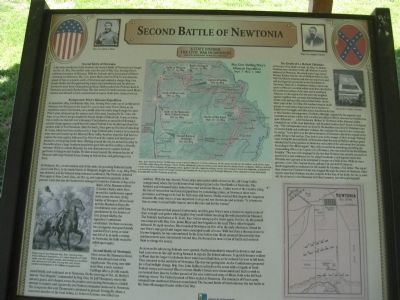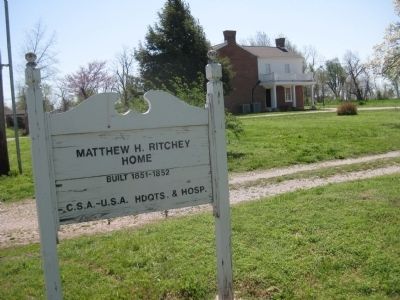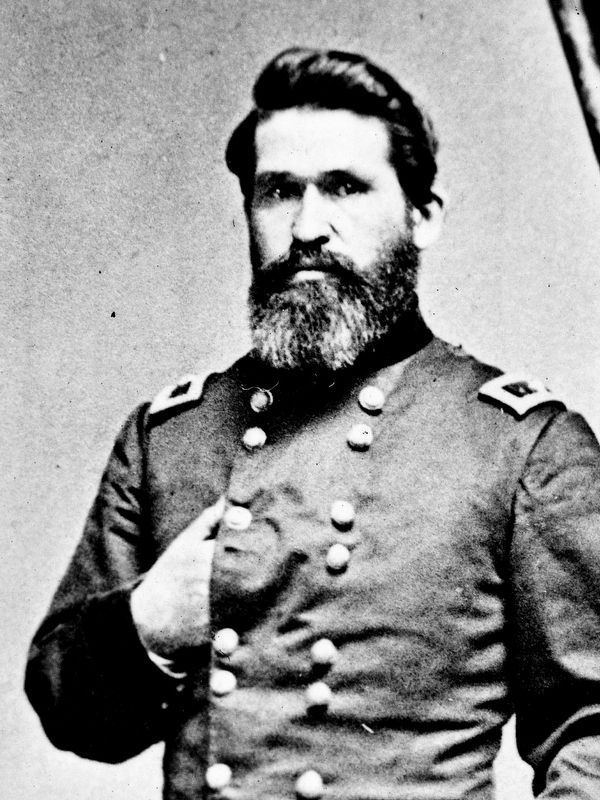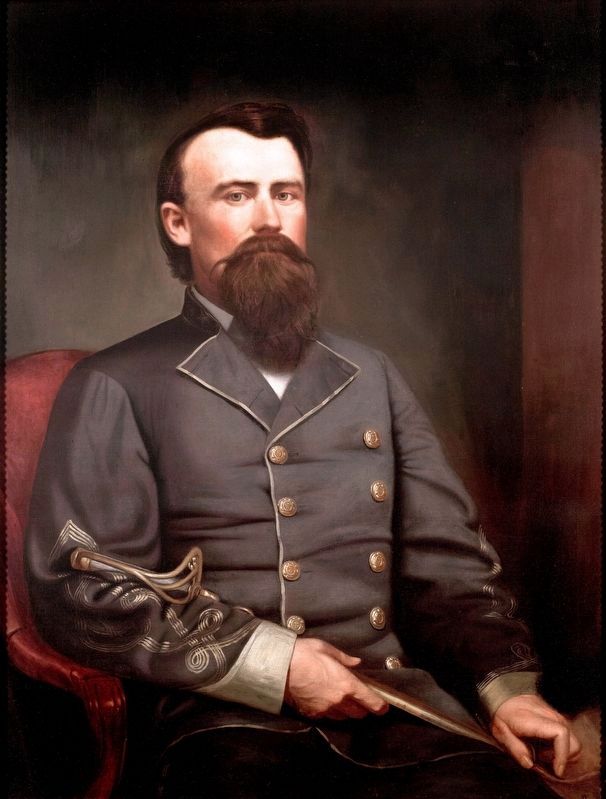Newtonia in Newton County, Missouri — The American Midwest (Upper Plains)
Second Battle of Newtonia
A State Divided: The Civil War in Missouri
Second Battle of Newtonia
A few miles southwest of this location, the Second Battle of Newtonia was fought on Oct. 28, 1864. The conflict came near the end of Maj. Gen. Sterling Price’s celebrated invasion of Missouri. With the Federals still in hot pursuit of Price’s retreating Confederates, Maj. Gen. James Blunt observed Price’s rear elements ahead of him on a prairie south of Newtonia and ordered a charge. Brig. Gen. Joseph Shelby saw the approaching enemy and immediately sent his division forward to meet them. Outnumbered Blunt, Shelby pushed the Federals back to Newtonia and nearly flanked them. The late arrival of reinforcements saved Blunt’s column and allowed a brief counterattack at sunset. Both sides claimed victory.
Background: Price’s Missouri Expedition
In September 1864, Confederate Maj. Gen. Sterling Price rode out of northeastern Arkansas into Missouri at the head of 12,000-man army. Price’s Raid, as the expedition came to be known, cut a swath some 600 miles long through the state. Price’s army advanced up the eastern end of the state, heading for St. Louis. On Sept. 26-27, Price’s troops fought the bloody Battle of Pilot Knob. It was a victory, but a costly one that left over a thousand Confederates as casualties following a suicidal charge against a small but well armed Federal force hunkering behind the earthen walls of Fort Davidson. After the baffle, Price gave up the idea of attacking St. Louis, which had been reinforced by a large Federal army. Instead, he turned his army west and headed up the Missouri River valley. Another objective had been to capture the state capital, Jefferson City. Price found the capital well fortified and decided to avoid giving battle there. Skirting around the city, he moved his army to Boonville where a large Southern population gave him and his soldiers a friendly welcome. While in central Missouri, he sent detachments to capture Federal garrisons at Glasgow and Sedalia. He then moved toward the western border of Missouri with large Federal forces closing in behind him, and gathering in his front.
At Westport, Mo., on the western end of the state, the pursuing Federals finally closed with Price. In the fateful Battle of Westport, fought on Oct. 21-23, 1864, Price was defeated, and his battered army retreated southward. The Federals defeated Price again at Mine Creek, Kan., on Oct. 25, and captured two generals in the process. Later that day, the Southerners managed to hold the Federals at bay at the Battle of the Marmaton River (Charlot’s Farm) while Price moved his cumbersome supply train across the river. At the battles of Westport, Mine Creek and the Marmaton River, the Confederates were saved from annihilation by the heroics of Gen. Joseph Shelby, the legendary Confederate cavalryman. On those occasions, his courageous rear guard stands enabled Price’s army, or what was left of it, to make a retreat. At Newtonia, his skills would be called upon again.
Second Battle of Newtonia
Once across the Marmaton River, Price abandoned most of his supply train. His army, now little more than a mob, reached Carthage after a 56 mile march, rested briefly, and continued on to Newtonia. On the morning of Oct. 28, Shelby’s famous “Iron Brigade,” commanded by Brig. Gen. M. Jeff Thompson, was in the advance guard, and charged across the prairies surrounding Newtonia in a failed attempt to surprise and capture the two Federal companies stationed in Newtonia. The companies fled with Thompson’s command in pursuit. During the chase, a notorious member of the local militia, Lt. Robert Christian, was killed (see sidebar). With the way cleared, Price’s army proceeded south of town to the old Camp Coffee campground, where the Confederates had camped prior to the First Battle of Newtonia The battered and exhausted army halted there and went into bivouac. Unlike most of the country along the line of retreat that had been stripped bare by contending armies, at Newtonia there were provisions and forage to be had for both men and horses. Shelby realized that despite the desperate
situation the army was in, it was important to stop and rest the troops and animals: “It is better to lose an army in actual battle than to starve the men and kill the horses.”
The Federal pursuit had paused momentarily and this gave Price’s men a chance to regain some of their strength and gather what supplies they could before resuming the withdrawal from Missouri. The Federals had halted at Ft. Scott, Kan. before taking up the chase again. On Oct. 26, the pursuit was resumed with Maj. Gen. James Blunt and two brigades in the lead. Three other brigades followed. By rapid marches, Blunt reached Newtonia on Oct. 28 in the early afternoon. Ahead he saw Price’s rear guard and wagon train encamped south of town. With less than a thousand men in his two brigades, he was outnumbered by the force before him. Blunt assumed (incorrectly) that reinforcements were immediately behind him. He formed his men in line of battle and ordered them to charge the enemy.
As soon as the advancing Federals were spotted, Shelby immediately roused his division and soon had 2,000 men in line and moving forward to repulse the federal advance. It quickly became evident to Blunt that the larger Confederate force would soon flank him, so he ordered his men to fall back. They retreated to the outskirts of Newtonia. The day was getting late. As the Confederates prepared for a final twilight charge, Brig. Gen. John Sanborn arrived on the scene with a brigade of fresh Federal troops and covered Blunt’s retreat. Shelby’s forces were dismounted and had no wish to overextend their lines by further pursuit of the now reinforced army of Blunt. Both sides fell back claiming victory. The Federal pursuit of Price ended at Newtonia. The remnants of Price’s army retreated into northwest Arkansas unmolested. The Second Battle of Newtonia was the last battle in the Trans-Mississippi theater of the Civil War.
(sidebar)
The Death of Lt. Robert Christian
At he time of his death on Sept. 28, 1864, Lt. Robert Christian was a member of the 15th Missouri Cavalry stationed at Newtonia. He saved under Capt. James Ritchey. Ritchey was the son of Matthew Ritchey, who built the Ritchey mansion and also the stone barn and mill that figured prominently in the First Battle of Newtonia. Most of Lt. Christian’s military career was spent in Missouri-enrolled militia units that operated in the southwest section of the state and in northwest Arkansas. In this region, the war was truly neighbor against neighbor with constant skirmishing between militia units and guerrilla and partisan bands. By the latter years of the Civil War, this warfare between small groups of combatants degenerated into a vicious no holds barred struggle, and little mercy was shown for foes or their families and supporters. Christian, although regarded by his superiors and comrades as a brave soldier and a worthy and efficient officer, was seen by Confederates quite differently: “…a first lieutenant (Robert H. Christian) of the Missouri militia committed one of the most diabolical, cold-blooded murders that I heard of during my trip.” This correspondent went on describe the heartless execution by Christian’s men of several elderly and inoffensive civilians. He concluded his report to his commander by saying: “I have given you the above narrative of Christian’s acts at the request of the public living in that section. They took to you as the avenger of their wrongs.” Payback came during the Second Battle of Newtonia when the men of Shelby’s advance guard attacked the Federal garrison at Newtonia and scattered the unit except for Christian. According to the official report, “they only succeeded in overtaking and killing the commanding officer (one Captain [sic.] Christian), who was noted for his bloodthirsty brutality.” This was code language for the fact that Christian was actually executed (or murdered) as just retribution for his alleged misdeeds Local legends report that Christian was captured as he attempted to escape on a balky horse. While he was a prisoner, a lone rider, Samuel Moore, galloped up and shot Christian to death—supposedly in retaliation for the murder by Christian of his father. This report then claims that Christian’s body was dragged through the streets of Newtonia. Other reports state that Christian was also scalped. Al the time of his death, he was 34 years old. He is buried in the Newtonia Civil War Cemetery. (see above photograph).
(captions)
Maj. Gen. James G. Blunt
Brig. Gen. Joseph O. Shelby
Engraving of Confederate Maj. Gen. Sterling Price. Price’s Missouri Expedition, at a total distance of 1,434 miles, was the longest cavalry raid carried out by either side during the Civil War. During the raid, Price’s soldiers participated in 43 military engagements.
Maj. Gen Sterling Price’s 12,000-man army entered Missouri in three columns. As his army moved up the eastern end of the state and then west along the Missouri River Valley, detached units of various sizes were sent to attack Union outposts, destroy railroad tracks and other property of strategic value, gather recruits, capture military stores and weapons from the Federals, and pick the surrounding region clean of forage, hones and foodstuffs. During his raid through Missouri, Price claimed to have destroyed $10,000,000 worth of enemy property.
Grave of Lt. Robert Christian
Erected by Missouri Department of Natural Resources.
Topics and series. This historical marker is listed in this topic list: War, US Civil. In addition, it is included in the Missouri - A State Divided: The Civil War in Missouri series list. A significant historical month for this entry is September 1864.
Location. 36° 52.668′ N, 94° 11.01′ W. Marker is in Newtonia, Missouri, in Newton County. Marker is on Mill Street east of Market Street, on the right when traveling east. Touch for map. Marker is at or near this postal address: 520 Mill Street, Stark City MO 64866, United States of America. Touch for directions.
Other nearby markers. At least 8 other markers are within 11 miles of this marker, measured as the crow flies. First Battle of Newtonia (here, next to this marker); The Battles of Newtonia Commemoration (approx. 0.2 miles away); Granby School (approx. 4.8 miles away); Haas Warehouse Building (approx. 10.1 miles away); Haas Building (approx. 10.2 miles away); 20th Century Wars Memorial (approx. 10.2 miles away); Secession Convention at Neosho (approx. 10.2 miles away); Newton County World War II Memorial (approx. 10.2 miles away). Touch for a list and map of all markers in Newtonia.
Also see . . . Second Battle of Newtonia Site. National Register of Historic Places Registration Form (Submitted on August 20, 2013, by Dale Johnson of Hudson, Wisconsin.)
Credits. This page was last revised on January 6, 2022. It was originally submitted on May 3, 2013, by Dale Johnson of Hudson, Wisconsin. This page has been viewed 810 times since then and 27 times this year. Photos: 1, 2. submitted on May 3, 2013, by Dale Johnson of Hudson, Wisconsin. 3, 4. submitted on January 5, 2021, by Allen C. Browne of Silver Spring, Maryland. • Bernard Fisher was the editor who published this page.
Editor’s want-list for this marker. Wide shot of marker and its surroundings, photo of Ritchey mansion. • Can you help?



